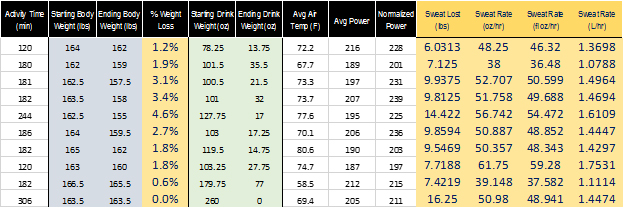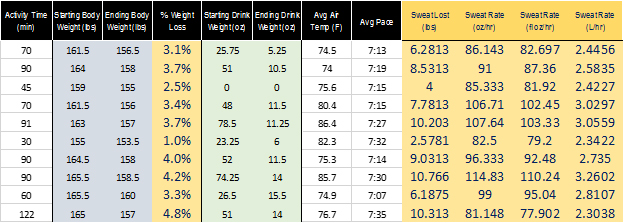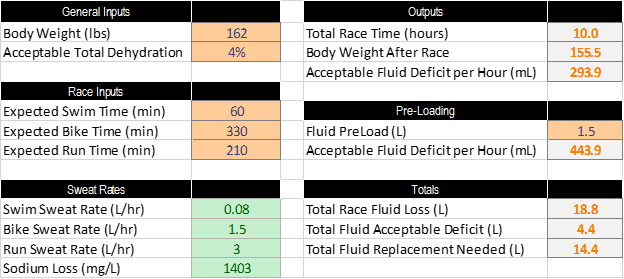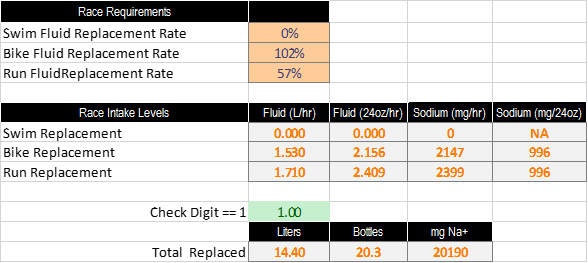With a high sweat rate comes challenges with athletic activity an athletic performance that I am all too familiar with. When it’s a hot day out and I have a workout, I usually fall apart. All of my worst training days have been when it’s hot out. I can easily lose 10+ pounds of weight during a long run or bike ride if I don’t pay attention and plan my hydration needs.
This has become more of a front and center issue in the last couple years after choosing to start Ironman racing and training. For shorter distances, sweat loss can be managed without too much thought. With the long distances, I really needed to make sure I understood how to manage water loss and dehydration for both training and racing. I have been lucky up till now that all of my Ironman events have been in relatively cooler weather. Training in Monterey County also tends itself to mostly cooler weather, especially in the early morning or later afternoon, when I tend to do the majority of my training. When I qualified for Kona, I knew I would have to take a serious approach to understanding my sweating “problem” and my overall hydration needs for hot weather racing. I knew I couldn’t just cross my fingers and hope for a cool day in Kona… it wasn’t going to happen.
My first step was to quantify my sweat rate. This is very easy to do. I simply weighed myself before and after workouts, and also weighed all the fluids I consumed during my workouts. I could calculate total weight loss over the length of my run and bike ride and account that for sweat lost during the activity. I started doing this in August, leading up to Ironman Kona for key workouts (typically on hotter days). I also recorded the average temperature during the workout and also my average pace or power for the workout. My hope was to correlate a sweat rate to a temperature and to an effort level. With this, I could approximate my sweat rate for a given effort level and air temperature.
Here is a sample of the data I collected for my bike rides:
From the above, you can see that 1.5 L/hr was a rough idea of my sweat rate on the bike. The last entry is actually my Ironman Kona Race Rehearsal, so the power would be close to race day. You can see I lost over 16 lbs of sweat on that ride, and it was under 70 degrees out. That’s a lot of sweat! I nailed the hydration though, because I lost no weight at all on the ride.
Of course, I really didn’t hit any temperatures which would accurately represent the heat I would get in Kona. I was lucky to see some unusually high temps for Monterey, but that still wasn’t enough. I wonder if there is a maximum sweat rate at which you really can’t sweat any more. I imagine, at some point I would hit my maximum sweat rate and temperatures above a certain point wouldn’t matter as I wouldn’t sweat any more.
Here is a sample of the data I collected for my runs:
From the above, you can see I can easily hit 3 L/hr sweat rate when it began to heat up above 80 degrees. To me, this was most disturbing part of my findings. 3 L/hr is a ton of sweat. There is no way I can drink anywhere close to 3 L/hr while running.
During this time of testing, I was also doing sauna heat acclimatization where I would sit in a dry sauna for 15-45 minutes 3-4 days a week to prepare for the Kona heat. Heat acclimatization increases blood plasma and also increases ones sweat rate and affects how quickly they begin to sweat. I could see the affects of this in the data as my sweat rate did seem to increase per temperature/pace over time. I’m still not sure if this is a great strategy for me. Given that I already sweat more than most, I’m not sure I want to make my body sweat even more. I’m not sure that extra sweat means more cooling or if it just means I can dehydrate that much easier. I’m still not sure heat acclimatization works for me and my situation, where I already have a very high sweat rate at baseline. I need to do some more research on this to see what is best for me next time.
I also did the same testing for swimming, but I noticed I didn’t really lose any weight swimming. The only weight I lost swimming was actually due to going pee (yes I get out of the pool or wait till after the workout) and not due to any sweating that I could measure. My fluid loss for swimming was under 0.1 L/hr.
So I now had my expected and approximate sweat rates for swimming, biking and running. Next, I wanted to learn more about sodium and electrolyte loss and replacement. The easiest and most cost effective option was to do a Levelen sweat sodium test. For $75, Levelen will send you a piece of gauze to tape on your forearm during a short run to collect sweat and sodium. They also provide you tweezers and a tube to pull out the gauze after the workout and ship them back the sweat soaked gauze for analysis. I did this simple test during a 45 minute run in 75 degree weather. Here were the results:
Sweat Rate 2.42 L/hr
Sweat Na+ 61 mmol/L 3395 mg/hr
Sweat K+ 7.0 mmol/hr
Sweat Cl- 60 mmol/L 5140 mg/hr
NaCl loss 8.5 g/hr
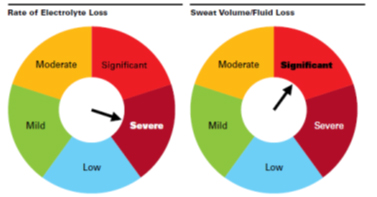
Just as I expected… I was on the extreme end of the scale for sweat rate and also sodium loss. The above equates to 1403 mg of sodium lost per liter of sweat. That’s a crazy amount of sodium! The FDA RDA for sodium is 2300 mg per day for an adult. That means, in 1 hour of running (3L of sweat), I lose almost 2 full days intake of salt…. In 1 hour!
So now, I had a good idea of my sweat loss rate and also a data point for my sodium loss rate. Now the question is, how much do I need to replace during a race. All of it? Some of it? None of it? Certainly, I knew I needed to replace most of my fluid loss. I know that when I get below 155 lbs of body weight I feel pretty crummy and fall apart on the bike or run. So I know I can’t lose more weight to get below 155 (or I cramp up and can barely move). But what about sodium? I’ve never really taken salt pills or any sodium supplement outside of what was in my sports drink and food.
The new school of thought, specifically from people like Tim Noakes and Phil Maffetone is, you just need to drink to thirst and do not need to supplement with electrolytes like sodium. I have been following Tim Noakes and his ideas for a while. I have read his book Waterlogged, and listed to countless podcasts and read countless articles from him. His concept is very appealing because it relies on listening to the body and only drinking when thirsty. This is really appealing because it takes all the work out of trying to stay hydrated… just drink when you’re thirsty and you’ll be fine. Noakes also doesn’t recommend sodium supplementation when exercising because, he says, our bodies have enough internally stored sodium to sustain us and that sodium loss (as measured per the test above) has more to due to your daily salt intake from diet than your sodium needs during exercise.
The problem for me is I have used this theory and have had very limited success with it. I tended to train and usually race using thirst as a guide for water intake, and also not supplemented with any sodium. The problem for me, as mentioned above, is I always fall apart on hot days or long workouts. All my race rehearsal training days, where I worked out for 5-8 hours, have always been huge failures due to dehydration (as measured via body weight loss). I always cramped up so bad I could barely move and barely made it home. I feel like I’m pretty in touch with my body and how I’m feeling, but maybe I have no idea when I’m thirsty and I don’t drink when I should. Whatever it is, the drinking to thirst theory doesn’t seem to work well for me right now.
I decided for Kona, to not follow that school of thought and go back to a more prescribed approach to fluid intake and sodium intake, at least as a starting point.
So next I needed to figure out how much fluid and sodium I should take at Kona. On the bike, I knew I could manage the 1.5 L/hr of water I would be losing as I had practiced taking in this much water quite a few times. The run as another story. There is no way I could drink anywhere near 3 L/hr to replace all my fluid loss. I’ve heard some say that about 800 mL/hr is about all you can absorb. I was hoping that wasn’t true.
I next contacted Skratch Labs to get some help. They seemed to be really on top of helping endurance athletes with their hydration needs and I liked their products for all of my training. Skratch was a great help, and after a couple back-and-fourths over email, I got a great understanding of how they approached hydration and fluid replacement. From this I began to build out my baseline formulas for my Kona hydration planning.
The starting point is your baseline body weight and then a maximum acceptable dehydration level. Skratch said that they have seen 4% dehydration as an acceptable level before performance loss. I would agree with this based on my data, as my baseline body weight is 162 lbs, so 4% dehydration would be about 155 lbs (right where I notice I begin to fall apart). From there, they key is really pre-loading with fluid before starting the race. Using something like Skratch Hyper Hydration Mix, you can use the extra sodium it has to help with water retention to preload your body with sodium and fluid.
If I am able to pre-load my body with fluid, and taking into account an acceptable level of dehydration throughout the race, I can come up a level of fluid replacement needed in the race which will be a certain level less than the fluid lost due to sweat.
Here is my data I put together in preparation for Kona:
I start by entering my body weight and level of acceptable dehydration after the race. I also enter anticipated race times (don’t need this too much as you can plan on a per-hour basis if needed). I then enter all my expected sweat rates for swim, bike and run.
The output on the right, shows my acceptable fluid deficit per hour in mL (293.9). This means, for a 10 hour race, I do not need to replace 293.9 mL per hour of my sweat loss. So if I sweat at 1 L/hr, I would only need to take in (1L – 293.9mL) 706.1 mL/hr of fluid in order to be fine and still be at only 4% dehydration after the race.
From there, I estimated I can pre-load fluid the days leading up to the race and race morning up to a total of 1.5 L. This would mean my body would be heavier when I started the race by that extra 1.5L of fluid I would be holding (with the help of sodium). This would then put my acceptable fluid deficit even higher at 443.9 mL/hr.
In the totals you can see I expected to lose 18.8L of fluid during the race but only needed to replace 14.4L during the whole race.
Next is to figure out how to replace that 14.4L of fluid throughout the race. I obviously cannot replace it during the swim (unless I end up drinking ocean water).
I played with different replacement rates for swim, bike and run. I put in 0% for swim, since I would not be drinking any during the swim. I tried to hit over 100% replacement on the bike, just because I knew it was easier to handle drinking water on the bike than while running. If I hit 102% replacement of fluid on the bike and only 57% replacement on the run, then I still could hit that 14.4 L of total fluid needed. I thought this would be the best strategy for me in Kona.
This level of fluid replacement ended up being about 70% of my BTA bottle per aid station on the bike and about 10 fl oz of fluid per aid station on the run. Pretty doable.
One other very important thing to note (that Skratch brought to my attention) that plays into this is managing body temperature. If I could use external cooling to lower my sweat rate, I would be in a much better position and not need quite as much fluid replacement, and more wiggle room with these numbers. Keeping the body cool by dumping water on your body during the bike and run, and using ice could really bring down my total fluid needs by reducing my sweat rate. I didn’t know how to really quantify this, but I knew I chose moderate sweat rates based on Monterey temperatures so, I figure I could just use as much cold water and ice as possible as an experiment in Kona. If anything, I would just be less dehydrated at the end of the day if all worked out.
Now that I knew how I planned to replace fluid in the swim, bike and run, I just took my sodium loss rate and figured out about how much sodium I needed to hour and per bottle of water I took in. This would not be all the sodium I lost in sweat, but just like water, I would replace most, but not all, sodium loss for the day. I then thought about when I could take in Skratch Hyper Hydration (pre-swim, bike special needs) and added up how much sodium what was. I took my total sodium needs, subtracted what I would take in from Hyper Hydration (and what is in my food I take in during the race) and then calculated about how many SaltStick pills I would need per hour or per bottle of water.
All of this is a bit overkill, I think. I really just wanted to use this as a starting point to figure out how to manage sodium and fluid intake for Kona. I think sometimes, you can overanalyze things which ends up hurting more than helping. But I guess that’s all part of the fun of triathlon. Triathlon is one big problem (or maybe lots of little ones) that is fun and interesting to figure out.
In the future, I really want to do another sweat-sodium test for another data point to further validate my own data. I think I have a much better idea of my fluid needs, but am only really scratching the surface on sodium needs. Plus what about all the other electrolytes! I think I would really need to spend a lot of time training and racing in the heat to really dial this in, which probably isn’t going to happen any time soon.

